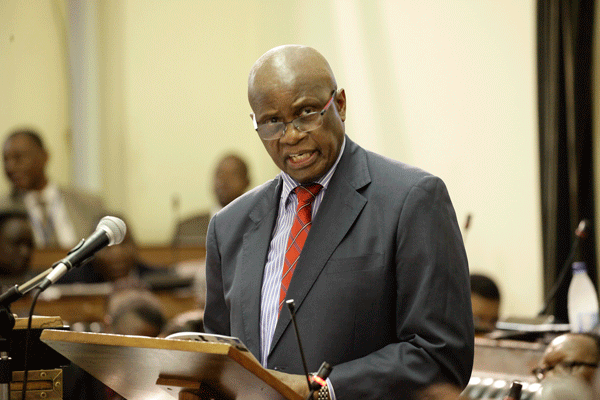
Finance minister Patrick Chinamasa last week reacted angrily to a report by The Standard revealing that his ministry had ignored internal advice that the command agriculture financing model was flawed.

The advisory note generated by the public debt management office in the Finance ministry raised a number of issues on the implementation of the controversial programme championed by Vice-President Emmerson Mnangagwa.
Chinamasa claimed the issues raised in the document, compiled by the ministry he superintends had since been addressed, but did not say how. For the benefit of our readers, we reproduce the document below without any editing.
SAKUNDA FACILITIES
Introduction
The fact that there are local companies e.g. Sakunda, that are willing to avail funds to Government for stimulating the economy is very welcome. Such companies should be commended for exploiting opportunities in the home front. The Government of Zimbabwe signed two agreements with Sakunda Holdings for Special Maize Programme which include the US$85 Million (irrigated land) and US$75 Million (non-irrigated land). There are similar proposed facilities for the winter wheat and roads rehabilitation.
The following issues are of concern:
1. There is capitalisation of interest upfront, then an additional coupon rate of 5%. Interest and facilitation fee charged on the Loan Agreement are capitalised at signature date before interest is accrued, i.e. the principal amount on the TBs issues is the capitalised amount which then carries a coupon rate of 5%.
- Chamisa under fire over US$120K donation
- Mavhunga puts DeMbare into Chibuku quarterfinals
- Pension funds bet on Cabora Bassa oilfields
- Councils defy govt fire tender directive
Keep Reading
2. Given the above, the effective interest rate on this facility is 15% (interest 6%, facility fee 1,5 & coupon rate 5%) and therefore it should be negotiated downwards in-line with the 2017 Monetary Policy Statement and considering that the facility is targeted to the agricultural sector.
3. The Agreement assumes a bullet disbursement. However, disbursements are being staggered and therefore Government is paying interest on disbursed funds.
4. Government should either issue a TB or contract a loan, instead of duplicating the two instruments concurrently.
5. The agreement does not have a schedule of actual inputs and their respective prices, making it difficult to assess the magnitude and cost of the Facility.
6. In the implementation of this Facility, there is potential conflict of interest, lack of checks and balances and no competitive bidding, which is against good corporate governance and in violation of State Procurement Board Regulations. For example, the Financier is responsible for procurement of all inputs and there is a huge risk of overpricing.
7. There is need for proper verification of hectarage to be planted in order to avoid over commitment, which would result in extra costs to Government from the committed funds.
8. Sakunda have traded all the issued TBs in breach of the non-tradability features on the TBs. In other words, the trading of the TBs by Sakunda plus the repayments of the loan through both the NOCZIM Debt Redemption Fund and the Budget is tantamount to Government funding the whole programme albeit, at a very high cost. Government should have traded its TBs directly to the market without involving third parties.
9. There have been notable delays in the procurement and distribution of inputs thereby reducing productivity;
10. There is notable delay in payment of suppliers by Sakunda, yet Government is being charged interest on the full amount of the loan. This has resulted in some supplier some supplier suspending delivery of inputs.
11. Lack of monitoring and evaluation mechanisms on the utilisation of the facilities.
12. The Facilities include inputs and administration costs (including vehicles, motorbikes, e.t.c), which have been proposed to be passed on to the Farmer. This will result in a sharp increase in the cost of inputs, above the market prices, yet selling price of maize is expected to go down because of abundant supply of maize locally and in the region.
13. Stop order agreements have not been signed between the Farmers and GMB, making it difficult to recover the costs of inputs from the farmer. The delay has been a result of lack of consolidated list of all beneficiaries of the facility. This will make it difficult for Government to recoup from the beneficiaries thereby promoting the culture of not payment and worsen Government’s indebtedness.
14. Government is exempting Sakunda inputs procured from taxation, yet there is no corresponding reduction of the input prices charged to Farmers.
15. There are no risk mitigating measures in case: i) the farmer fails to pay due to unfavourable weather condition, unwillingness to pay and any reason including natural disasters; and ii) Sakunda fails to deliver inputs on time;
16. Requests for payment are being forwarded to Treasury and the NOCZIM redemption fund without invoices and list of inputs distributed by Sakunda.
Recommendations
1. Government needs to be proactive, than being reactive, in designing programmes and mobilizing funding for economic growth, and timing is essential.
2. Government needs to improve on its capacity to negotiate better deals.
3. Before Government contracts a new facility, it is prudent to review the existing facilities in-order-to draw any lessons especially to assess any possible shortcomings, successes etc.
4. The implementing agent should avoid add-ons to the facilities which are not included in the initial scope to avoid the ballooning of costs. It is therefore important to come up with a comprehensive set of requirements for the entire programme covering the targeted hectarage, procurement, disbursement, planting, harvesting and marketing.
5. There should be a computerised, up-to-date and secure database of all beneficiaries and all inputs distributed;
6. The inputs procurement should either be done by Government or be subjected to competitive bidding.
7. Alternatively, these facilities should be implemented through normal banking channesl where Sakunda avails funds/loans to Government upfron for procurement of the inputs.
8.There is need to design and negotiate agricultural facilities well ahead of the farming season. It is then possible to negotiate for lengthening of the maturities and stagger repayment of the facility to reduce pressure of the Fiscus.
9. Repayment of the facility should only be made if there are supporting documentation to the claim in the form of invoices, delivery notes, etc.
10. Given the support given to agriculture it is prudent for the Government to also mobilise funding for other sectors especially to complimentary sectors such as manufacturing for value addition and beneficiation as enunciated in Zim Asset.









